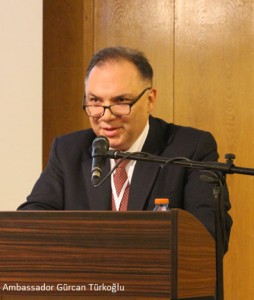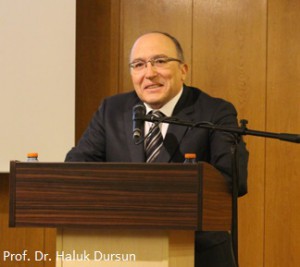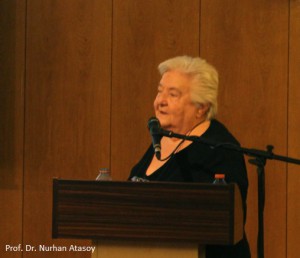Matrakçı Nasuh, distinguished by his multifaceted identity as a sportsman, mathematician, historiographer and artist, was commemorated on the 450th anniversary of his death with a symposium, sponsored jointly by the Turkish National Commission for UNESCO and the Center for Turkish Literature of Bilkent University. Prof. Halûk Dursun, the undersecretary of the Ministry of Culture and Tourism of Turkey, Gürcan Türkoğlu, ambassador and the vice president of the Turkish National Commission, and Prof. Adnan Akay, the provost of Bilkent University, were present at the symposium.
 The keynote speakers were Assoc. Prof. Nuran Tezcan of Bilkent University, Ambassador Türkoğlu and Prof. Dursun. Dr. Tezcan stated that Ottoman historiography requires a respectable knowledge of prose literature. Because Matrakçı Nasuh demonstrates his accumulation of knowledge in his prose works, he should in her view be regarded as an Ottoman author. She compared Matrakçı’s thoughts on art with the ideas of Picasso, noting that there are many similarities between the views of these two artists. Ambassador Türkoğlu observed that Bilkent University, in its relatively brief history, has already received widespread attention abroad in the spheres of education, culture and science, with its innovative research laboratories, fine symphony orchestra and superb library. Similarly, Prof. Dursun drew attention to the pioneering role of Bilkent University in both scientific and cultural activities. He noted that the Enderûn School of the Topkapı Palace was constructed like a campus, and underlined the significance of the Palace library as a cultural inheritance.
The keynote speakers were Assoc. Prof. Nuran Tezcan of Bilkent University, Ambassador Türkoğlu and Prof. Dursun. Dr. Tezcan stated that Ottoman historiography requires a respectable knowledge of prose literature. Because Matrakçı Nasuh demonstrates his accumulation of knowledge in his prose works, he should in her view be regarded as an Ottoman author. She compared Matrakçı’s thoughts on art with the ideas of Picasso, noting that there are many similarities between the views of these two artists. Ambassador Türkoğlu observed that Bilkent University, in its relatively brief history, has already received widespread attention abroad in the spheres of education, culture and science, with its innovative research laboratories, fine symphony orchestra and superb library. Similarly, Prof. Dursun drew attention to the pioneering role of Bilkent University in both scientific and cultural activities. He noted that the Enderûn School of the Topkapı Palace was constructed like a campus, and underlined the significance of the Palace library as a cultural inheritance.
The symposium sessions that followed focused on various areas of Matrakçı Nasuh’s wide-ranging achievements, as well as the context of his life and times. Prof. Nurhan Atasoy analyzed the contemporary reality of the cities, from Galata-İstanbul to Baghdad, depicted in his urban miniatures. Assoc. Prof. Gottfried Hagen of the University of Michigan, Ann Arbor, focused on the worldwide aspects of cartography during Matrakçı Nasuh’s period and assessed his techniques of illustration and geographic design.
 In the afternoon sessions, Prof. Feza Günergun discussed the transformation of the scientific approach of the Ottoman elites as they began to follow Western scientific perceptions and to diverge from the Eastern perspective during the 16th century. Assoc. Prof. Zeynep Yürekli-Görkay examined Matrakçı Nasuh’s various miniature manuscripts and questioned whether these works were the production of an individual or a collective effort. Prof. Melek Dosay-Gökdoğan compared the content and methods of problem-solving in the mathematics books by Matrakçı Nasuh with the curriculum of contemporary mathematics. Assist. Prof. Davut Erkan drew attention to Matrakçı Nasuh’s identity as a historiographer and explored his biographical background. As a result of this investigation, Dr. Erkan confirmed that Matrakçı Nasuh was born in Pristina, not Bosnia. Dr. Walter Posch asserted that historiography should also be recognized as a political way of writing. Furthermore, he called into question the epithet “Karagöz” as connected with Matrakçı Nasuh, correlating this name with a Balkan family. Prof. İsmail Hakkı Aksoyak analyzed a work of Matrakçı Nasuh on the sports of war.
In the afternoon sessions, Prof. Feza Günergun discussed the transformation of the scientific approach of the Ottoman elites as they began to follow Western scientific perceptions and to diverge from the Eastern perspective during the 16th century. Assoc. Prof. Zeynep Yürekli-Görkay examined Matrakçı Nasuh’s various miniature manuscripts and questioned whether these works were the production of an individual or a collective effort. Prof. Melek Dosay-Gökdoğan compared the content and methods of problem-solving in the mathematics books by Matrakçı Nasuh with the curriculum of contemporary mathematics. Assist. Prof. Davut Erkan drew attention to Matrakçı Nasuh’s identity as a historiographer and explored his biographical background. As a result of this investigation, Dr. Erkan confirmed that Matrakçı Nasuh was born in Pristina, not Bosnia. Dr. Walter Posch asserted that historiography should also be recognized as a political way of writing. Furthermore, he called into question the epithet “Karagöz” as connected with Matrakçı Nasuh, correlating this name with a Balkan family. Prof. İsmail Hakkı Aksoyak analyzed a work of Matrakçı Nasuh on the sports of war.
Matrakçı Nasuh appears as a muse of contemporary Turkish literature through his works and gifted personality, and the final session of the symposium was related to this aspect of his influence, with Prof. Kemal Özmen drawing attention to the intertextuality between Matrakçı Nasuh’s Galata miniature and the book-length poem “Galata” by İlhan Berk. Prof. Özmen analyzed the influence of Matrakçı Nasuh’s miniature paintings on Berk’s creativity, looking in particular at how the latter perceived the Galata miniature in his mind, while his persona in the poem was wandering the streets and observing the panorama of Istanbul; in short, at how a naive perception of the city inspired Berk’s creative process. In that the symposium began with a discussion of the Galata miniatures, this last paper on Berk’s “Galata” brought the proceedings to a close in a cyclic fashion.
 However, the commemoration of Nasuh Matrakçı’s life and work was not yet quite complete. Following the academic presentations, Efkan Çalış and his team performed a sword and matrak show, illustrating one more aspect of this polymath’s achievements: his invention of matrak, a game played with wooden staves. The interactive demonstration arranged by Mr. Çalış, who endeavors to keep matrak alive as a contemporary sport in Turkey, aroused great interest in the audience.
However, the commemoration of Nasuh Matrakçı’s life and work was not yet quite complete. Following the academic presentations, Efkan Çalış and his team performed a sword and matrak show, illustrating one more aspect of this polymath’s achievements: his invention of matrak, a game played with wooden staves. The interactive demonstration arranged by Mr. Çalış, who endeavors to keep matrak alive as a contemporary sport in Turkey, aroused great interest in the audience.
